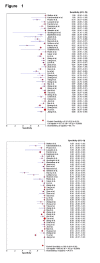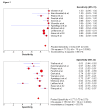Diagnostic value of fine-needle aspiration biopsy for breast mass: a systematic review and meta-analysis
- PMID: 22277164
- PMCID: PMC3283452
- DOI: 10.1186/1471-2407-12-41
Diagnostic value of fine-needle aspiration biopsy for breast mass: a systematic review and meta-analysis
Abstract
Background: Fine-needle aspiration biopsy (FNAB) of the breast is a minimally invasive yet maximally diagnostic method. However, the clinical use of FNAB has been questioned. The purpose of our study was to establish the overall value of FNAC in the diagnosis of breast lesions.
Methods: After a review and quality assessment of 46 studies, sensitivity, specificity and other measures of accuracy of FNAB for evaluating breast lesions were pooled using random-effects models. Summary receiver operating characteristic curves were used to summarize overall accuracy. The sensitivity and specificity for the studies data (included unsatisfactory samples) and underestimation rate of unsatisfactory samples were also calculated.
Results: The summary estimates for FNAB in diagnosis of breast carcinoma were as follows (unsatisfactory samples was temporarily exluded): sensitivity, 0.927 (95% confidence interval [CI], 0.921 to 0.933); specificity, 0.948 (95% CI, 0.943 to 0.952); positive likelihood ratio, 25.72 (95% CI, 17.35 to 28.13); negative likelihood ratio, 0.08 (95% CI, 0.06 to 0.11); diagnostic odds ratio, 429.73 (95% CI, 241.75 to 763.87); The pooled sensitivity and specificity for 11 studies, which reported unsatisfactory samples (unsatisfactory samples was considered to be positive in this classification) were 0.920 (95% CI, 0.906 to 0.933) and 0.768 (95% CI, 0.751 to 0.784) respectively. The pooled proportion of unsatisfactory samples that were subsequently upgraded to various grade cancers was 27.5% (95% CI, 0.221 to 0.296).
Conclusions: FNAB is an accurate biopsy for evaluating breast malignancy if rigorous criteria are used. With regard to unsatisfactory samples, futher invasive procedures are required in order to minimize the chance of a missed diagnosis of breast cancer.
Figures





Similar articles
-
Signs and symptoms to determine if a patient presenting in primary care or hospital outpatient settings has COVID-19.Cochrane Database Syst Rev. 2022 May 20;5(5):CD013665. doi: 10.1002/14651858.CD013665.pub3. Cochrane Database Syst Rev. 2022. PMID: 35593186 Free PMC article.
-
Xpert Breast Cancer STRAT4 Assay using fine-needle aspiration biopsy samples in a resource-constrained setting: a prospective diagnostic accuracy study.Lancet Oncol. 2024 Nov;25(11):1440-1452. doi: 10.1016/S1470-2045(24)00456-X. Epub 2024 Oct 3. Lancet Oncol. 2024. PMID: 39369731
-
Intraoperative frozen section analysis for the diagnosis of early stage ovarian cancer in suspicious pelvic masses.Cochrane Database Syst Rev. 2016 Mar 1;3(3):CD010360. doi: 10.1002/14651858.CD010360.pub2. Cochrane Database Syst Rev. 2016. PMID: 26930463 Free PMC article.
-
Imaging modalities for characterising focal pancreatic lesions.Cochrane Database Syst Rev. 2017 Apr 17;4(4):CD010213. doi: 10.1002/14651858.CD010213.pub2. Cochrane Database Syst Rev. 2017. PMID: 28415140 Free PMC article.
-
Rapid, point-of-care antigen tests for diagnosis of SARS-CoV-2 infection.Cochrane Database Syst Rev. 2022 Jul 22;7(7):CD013705. doi: 10.1002/14651858.CD013705.pub3. Cochrane Database Syst Rev. 2022. PMID: 35866452 Free PMC article.
Cited by
-
Cytological and Pathological Correlation of FNAC in Assessing Breast Lumps and Axillary Lymph Node Swellings in a Public Sector Hospital in India.Patholog Res Int. 2013;2013:695024. doi: 10.1155/2013/695024. Epub 2013 Dec 17. Patholog Res Int. 2013. PMID: 24455419 Free PMC article.
-
Fine-needle aspiration cytology can play a role in neoadjuvant chemotherapy in operable breast cancer.ISRN Oncol. 2013 Jul 10;2013:935796. doi: 10.1155/2013/935796. Print 2013. ISRN Oncol. 2013. PMID: 23936675 Free PMC article.
-
The Role of Fine Needle Aspiration Cytology in Triple Assessment of Patients with Malignant Breast Lumps.Niger J Surg. 2020 Jan-Jun;26(1):35-41. doi: 10.4103/njs.NJS_50_19. Epub 2020 Feb 10. Niger J Surg. 2020. PMID: 32165834 Free PMC article.
-
Rapid differentiation of estrogen receptor status in patient biopsy breast cancer aspirates with an optical nanosensor.bioRxiv [Preprint]. 2024 Apr 1:2024.03.29.587397. doi: 10.1101/2024.03.29.587397. bioRxiv. 2024. PMID: 38617252 Free PMC article. Preprint.
-
Development of a cost-effective compact diode-laser-based photoacoustic sensing instrument for breast tissue diagnosis.J Biomed Opt. 2024 Jan;29(1):017002. doi: 10.1117/1.JBO.29.1.017002. Epub 2024 Jan 11. J Biomed Opt. 2024. PMID: 38213472 Free PMC article.
References
-
- Evans WP, Cade SH. Needle localization and fine-needle aspiration biopsy of nonpalpable breast lesions with use of standard and stereotactic equipment. Radiology. 1989;173:53–56. - PubMed
-
- Azavedo E, Svane G, Auer G. Stereotactic fine-needle biopsy in 2594 mammographically detected nonpalpable lesions. Lancet. 1989;1:1033–1035. - PubMed
Publication types
MeSH terms
LinkOut - more resources
Full Text Sources
Medical

